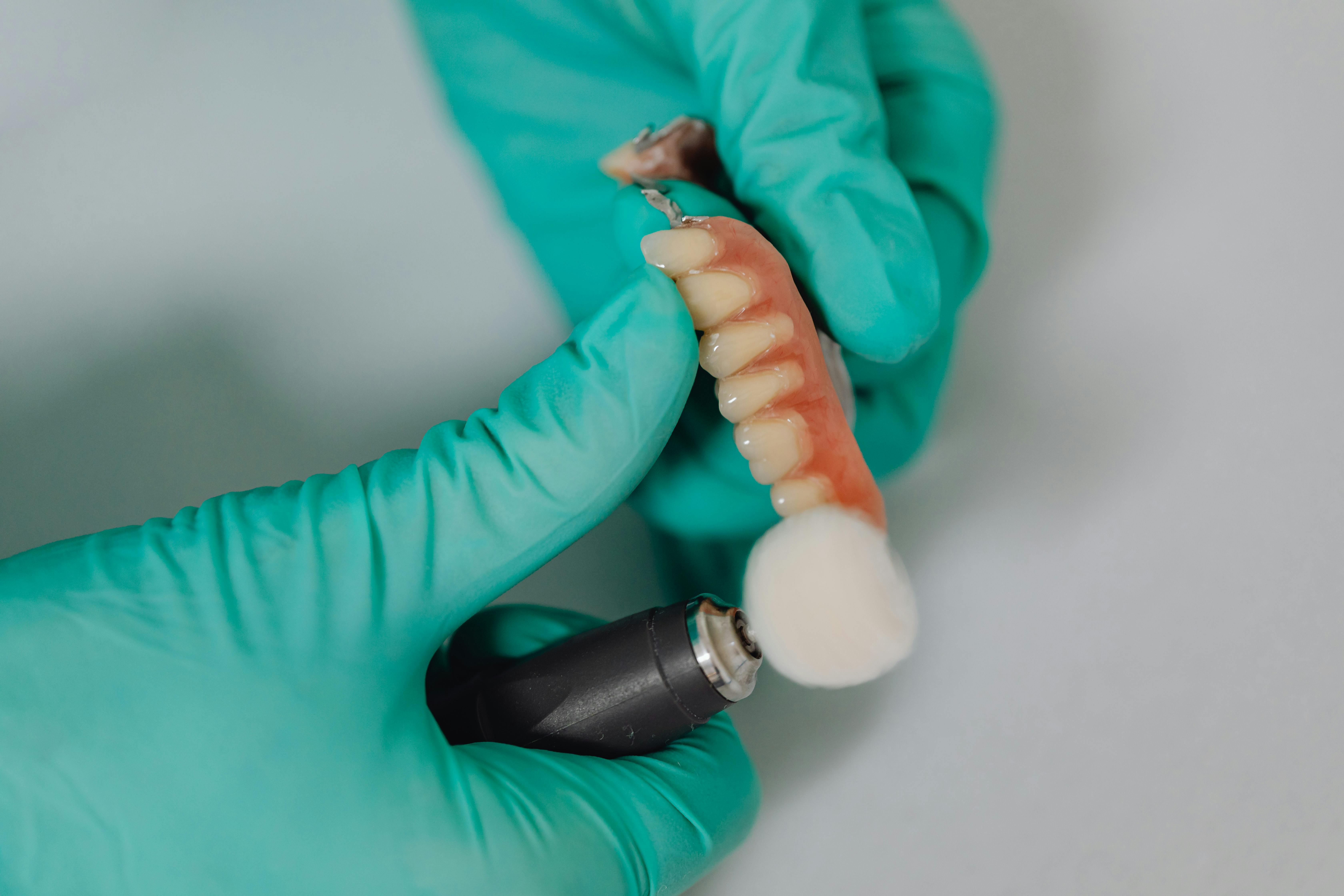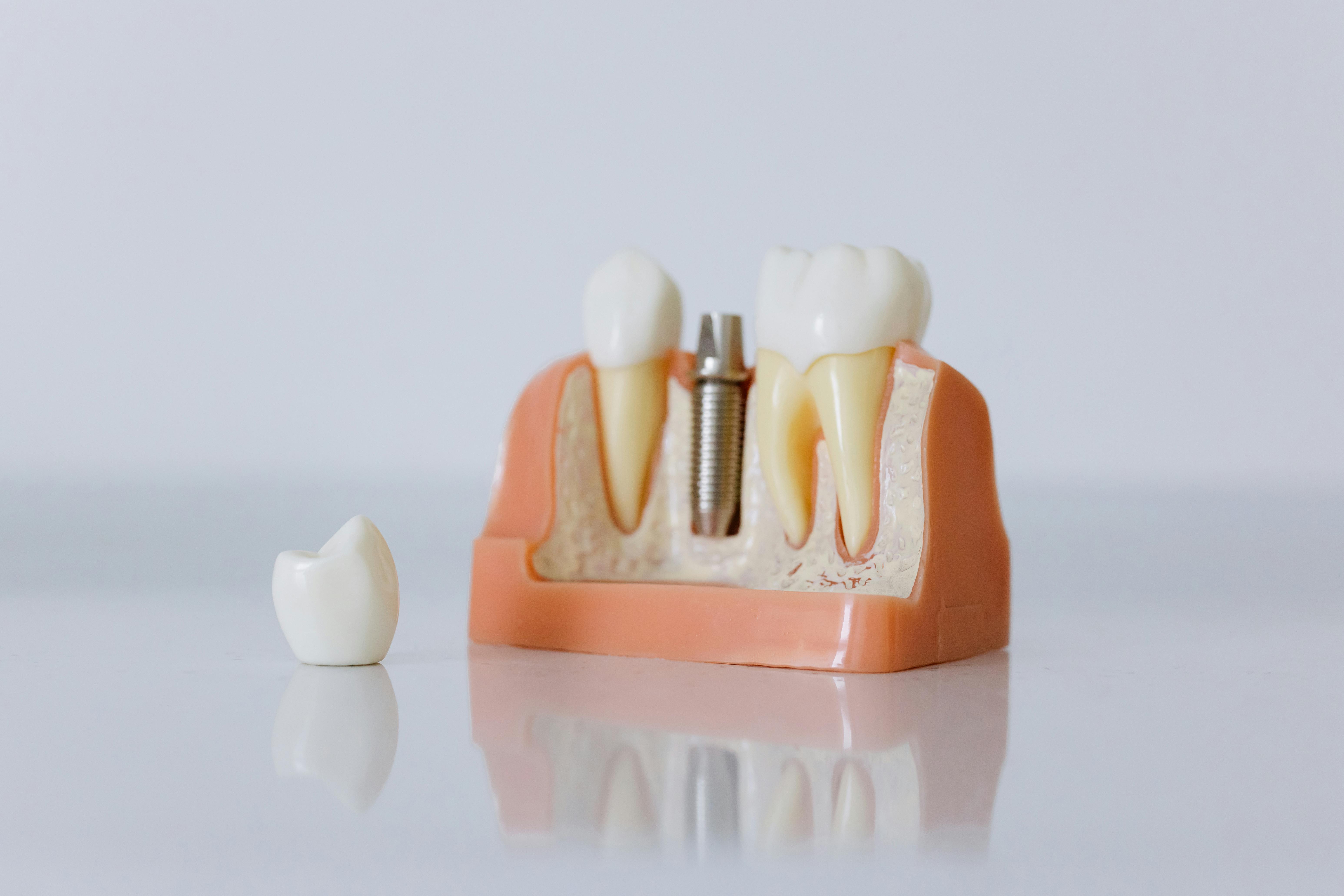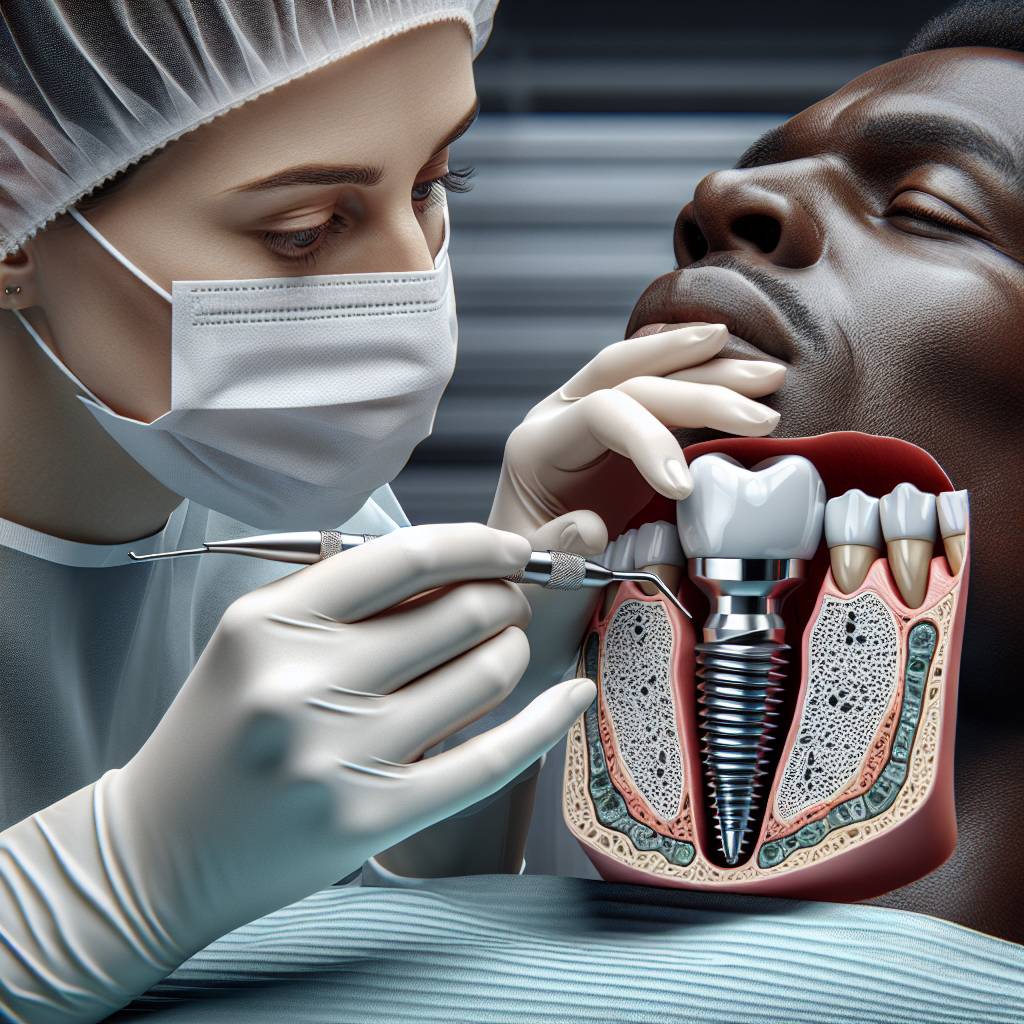Teeth implants are a common dental procedure used to replace missing or damaged teeth. They involve surgically inserting a metal post into the jawbone, which acts as an artificial tooth root. The post is then combined with a prosthetic tooth or crown, creating an artificial replacement tooth that looks and functions like a natural tooth. The process of placing teeth implants is complex and requires careful planning by an experienced dentist or oral surgeon. In this article, we’ll discuss the steps involved in putting teeth implants in, so you can understand what to expect during the procedure.A dental implant is a surgical procedure in which a metal post or frame is surgically placed into the jawbone beneath the gum line. The implant acts as an anchor for a prosthetic tooth or bridge. A screw is inserted into the post, and this screw holds the prosthetic tooth or bridge in place. Dental implants are a permanent and effective solution to missing teeth, and can last for many years with proper care and maintenance.
What is the Process of Getting Teeth Implants?
Teeth implants are an increasingly popular way to replace missing teeth and restore a confident smile. The process of getting a tooth implant involves multiple steps, including consultation, implant placement, and restoration. During consultation, the dentist will assess your oral health and discuss available options for replacing your missing tooth. After that, the implant is placed in the jawbone where it will serve as an artificial root for the new tooth. Finally, a crown or bridge is attached to the implant to complete the restoration process.
The first step in getting a dental implant is to make sure that you are a suitable candidate for the procedure. Your dentist will evaluate your medical history and perform a physical examination of your mouth to determine if you have enough healthy jawbone for the implant. They may also take X-rays or 3D scans of your jaw to get an even better idea of your bone structure.
Once you’re deemed a good candidate for dental implants, your dentist will place them in your jawbone using local anesthesia. The procedure takes about one hour per implant and involves placing small titanium posts into the jawbone where they will serve as anchors for replacement teeth. The posts are then left to heal and fuse with the surrounding bone while you wait for restorative treatment.
Once your mouth has healed from surgery, your dentist can begin restoring it with either a crown or bridge depending on how many teeth need to be replaced. A crown is used when replacing a single tooth while bridges are used when replacing multiple teeth at once. Both restorations are custom-made from porcelain or ceramic materials that look natural and blend in with existing teeth.
Getting dental implants can help you restore functionality and aesthetics back into your smile so you can feel confident again with eating and speaking normally! With proper care and maintenance, it’s possible that implants could last a lifetime!
Types of Teeth Implants
Teeth implants are a great way to replace missing or damaged teeth and restore your smile. There are several types of dental implants available, each with its own benefits and drawbacks. The most common types of dental implants include endosteal implants, subperiosteal implants, and single-tooth implants.
Endosteal Implants
Endosteal implants are the most common type of dental implant and involve surgically placing a metal post directly into the jawbone. These posts act as anchors for replacement teeth, such as crowns, bridges, or dentures. Endosteal implants require a longer healing period than other types of dental implants because they must be integrated into the jawbone before they can be used to support a prosthetic tooth.
Subperiosteal Implants
Subperiosteal implants involve placing a metal frame onto the top of the jawbone instead of surgically inserting it into the bone. The frame is then left to heal for several months until it becomes integrated with the jawbone. Once healed, artificial teeth can be attached to the posts that extend from the frame. This type of implant is often used for people who do not have enough healthy bone tissue in their jaws to support an endosteal implant.
Single-Tooth Implants
Single-tooth implants are used when only one tooth needs to be replaced. A small titanium post is inserted into the jawbone where the missing tooth was located and left to heal for several months until it is fully integrated into the jawbone. Once healed, an artificial crown is attached to the post and functions just like a natural tooth would. This type of implant is very stable and secure and requires minimal maintenance once it has been placed correctly in the mouth.
No matter which type of implant you choose, it’s important that you work closely with your dentist or oral surgeon to ensure that you get an implant that meets your needs and fits your lifestyle. Your dentist or oral surgeon will help you determine which type of dental implant will work best for you based on your individual needs and oral health history.
How Much Time Does it Take to Put Teeth Implants In?
The time it takes to place a dental implant varies depending on the complexity of the case. Generally, the entire process can take anywhere from one to four hours. This includes the initial consultation, preparation of the implant site, placement of the implant and any final adjustments that may be necessary. In some cases, it may be necessary to wait several months after the initial consult before the actual implant placement takes place in order to allow sufficient time for healing and bone regeneration. During this time, your dentist may recommend a bridge or denture as a temporary solution until your final restoration is ready.
The actual procedure for placing an implant involves making an incision in the gums and drilling a hole into the jawbone. This is where a titanium post will be inserted and secured into place with screws or other fastening devices. Once this is done, your dentist will then cover up the post with an abutment which provides support for a crown or bridge. After all of these steps have been completed, your dentist will then take impressions of your teeth so that a permanent restoration can be made and attached to the abutment.
Overall, you can expect to spend anywhere from one to four hours at your dentist’s office when getting dental implants put in place. However, this number can vary depending on how complicated your case is as well as any additional procedures you may need prior to implant placement such as bone augmentation or tissue grafting. Additionally, if you require multiple implants or need additional treatment such as tooth extraction prior to implant placement, then this could add additional time onto your appointment.
Are There Any Risks or Side Effects to Putting Teeth Implants In?
Teeth implants are generally considered a safe and effective procedure, however there are some risks and side effects associated with having teeth implants put in. The most common risks include infection, damage to surrounding teeth or other structures, nerve damage, and implant failure. Additionally, there may be some discomfort associated with the procedure and recovery period.
Infection is the most serious risk associated with teeth implants. This is why it is important that the dentist takes proper precautions when performing the procedure. This includes using sterile instruments and proper dental techniques to reduce the risk of infection.
Damage to surrounding teeth or other structures can also occur during the implant procedure. This is why it is important that the dentist takes special care when placing the implant to ensure that surrounding structures are not damaged in any way.
Nerve damage can also occur during teeth implant placement if not done properly. This can cause tingling, numbness, or pain in certain areas of the mouth. To reduce this risk, it is important that the dentist takes extra care when placing implants near nerves or other sensitive structures in the mouth.
Implant failure is another risk associated with having teeth implants put in. This occurs when an implant does not properly integrate into the bone structure of your jaw or does not properly support your artificial tooth replacement. It is important to make sure that you follow all instructions for aftercare in order to reduce this risk as much as possible.
Finally, there may be some discomfort associated with having teeth implants put in and throughout the recovery period following your procedure. However, this discomfort should subside over time as you heal from your surgery and get used to wearing your new artificial tooth replacement if necessary.
Overall, while there are risks and side effects associated with having teeth implants put in, they are typically minor when compared to all of the benefits they offer for improving oral health and restoring a beautiful smile!

How Much Do Teeth Implants Cost?
The cost of a dental implant can vary significantly depending on the individual’s needs. Depending on the type of implant, the location of the implant, and the complexity of the case, the cost can range from a few thousand dollars to tens of thousands of dollars. Generally, implants and related procedures are considered to be elective procedures and therefore not covered by most insurance plans. It is important to discuss all costs with your dentist prior to beginning treatment.
The cost of a single tooth implant typically ranges from $1,000 to $3,000. This includes the cost of the implant itself as well as associated surgical fees and other related expenses such as X-rays and anesthesia. The cost may also vary depending on how much bone must be grafted in order to support the implant. Additionally, if multiple teeth need to be replaced with implants or if there are other complex dental issues present, then this could drive up the overall cost.
In some cases, it may be possible for insurance companies to cover part or all of the costs associated with implants or related treatments. However, this is not always the case and it is important to understand if any procedure is covered before beginning treatment. In addition, some dentists offer payment plans that can help make implants more affordable for patients who are unable to pay for them out-of-pocket.
Overall, it is important for individuals considering dental implants to research their options thoroughly and understand what costs may be involved in order to make an informed decision that best meets their needs.
How Long Do Teeth Implants Last?
Teeth implants are a permanent solution for missing teeth, and with proper care they can last a lifetime. However, there are certain factors that can affect the longevity of the implant. The quality of the implant, how it’s placed, and how well it is taken care of can all play a role in how long it will last.
The quality of the implant is important because it affects how well it will integrate with the jawbone. The higher quality implants are made from titanium and are designed to bond with the surrounding bone tissue. A lower quality implant may not bind as well and could fail prematurely.
The placement of the implant is also important for its longevity. If an inexperienced dentist places an implant incorrectly, it may not hold as long as if it were placed properly. Additionally, if there is not enough bone to support an implant, or if there are other medical conditions present that could interfere with healing or osseointegration, then the implant may fail sooner than expected.
Finally, how well an implant is taken care of will also have an effect on its longevity. Proper oral hygiene is essential to keep plaque from building up and causing infection around the implant site. Additionally, regular dental visits can help catch any problems early before they become more serious and cause further damage to the implant or surrounding tissue.
Overall, teeth implants can last a lifetime with proper care and maintenance, but there are certain factors that can affect their longevity such as quality of materials used for the implants, placement by a qualified professional dentist and proper oral hygiene practices by patient himself/herself.
Recovery After Putting Teeth Implants In
Recovery after putting teeth implants in is usually a gradual process that can take several weeks to months. Immediately after the procedure, the patient may feel some soreness and swelling around the implant site. In order to manage this pain, the patient may be prescribed pain medication and antibiotics, which should be taken as directed. The patient should also make sure to attend all regularly scheduled follow-up appointments with their dentist in order to monitor healing progress.
Once initial healing is complete, dentures or crowns may be placed over the implant site in order to provide a more natural looking appearance and improve function. This process usually takes several weeks or months depending on the individual situation. During this time, it is important for patients to maintain good oral hygiene by brushing their teeth twice a day and flossing regularly. Following these steps can help prevent infections and other complications from developing during recovery.
In addition to following their dentist’s instructions for recovery, patients should also follow a healthy diet that includes plenty of fruits and vegetables as well as avoiding sugary snacks or drinks. This will help ensure that the implants are properly nourished during recovery and reduce the risk of complications developing later on.
Overall, recovery after putting teeth implants in can be a lengthy process that requires patience and dedication from both the patient and their dentist. By following their doctor’s instructions carefully as well as practicing good oral hygiene habits, patients can ensure that they heal quickly and safely from their dental implant surgery.

Conclusion
The process of getting teeth implants is a safe and reliable option for restoring your smile. It’s relatively painless and provides long-term benefits with proper care. The process of placing the implant can take anywhere from one to three visits to the dentist, depending on the type of implant being used. After placement, the dentist will need to periodically check the implant site for signs of infection or inflammation. With proper care, implants can last up to 20 years or more.
Overall, it is important to remember that any surgery comes with potential risks. That is why it is essential to discuss all your options with your dentist so you can make an informed decision about what is best for you and your smile.

